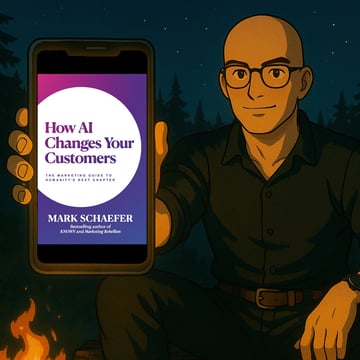
Strivenn Thinking
Pull up a seat at our
digital campfire
where story, strategy,
and AI spark
new possibilities
for sharper brands
and smarter teams.
AI Isn't the Risk. Waiting Is.
By Matt Wilkinson
Publicis' valuation grew more than 50% on AI. WPP lost 50% by waiting. For life science leaders, this is your moment.
Right now, two of the world's biggest marketing companies are on wildly diverging paths. One bet early on AI and is thriving. The other waited to see how it played out and is now fighting for survival.
WPP didn't fail because it made a bad bet on AI. It failed because it made no bet at all.
WPP - once worth nearly £9bn at the end of 2022 - has crashed to under £4bn in market value. WPP's CEO called the company's performance 'unacceptable' and admitted the media unit had 'lost its way'. Major clients like Mars and Bayer are walking. Its market value has dropped 55% in 3 years. The company that once dominated advertising is now at risk of being kicked off the FTSE 100.
Meanwhile, Publicis Group is winning. The company bet €12bn on AI starting in 2018 - four years before ChatGPT made AI fashionable. Today, 80% of its media revenue comes from AI-driven work. Creative's share of revenue has grown from 20% to 25% even as competitors struggle. Organic revenue growth guidance has been raised. CEO Arthur Sadoun told analysts they're winning accounts "without a pitch" because their AI integration differentiates them so completely. Since the end of 2022, Publicis' valuation has increased from £13bn to £20bn.
The gap between winners and losers is widening fast. Publicis' performance advantage versus its three main holding company peers was 430 basis points in 2024. It's expected to exceed 600 basis points in 2025.
If you're leading a life science commercial team that has yet to adopt AI, this should be your wake up call.
Your competitors are already moving
While most life science companies treat AI as a future consideration, a handful have moved decisively. They're not piloting. They're transforming.
Promega Corporation deployed ChatGPT enterprise across the entire company with CEO Bill Linton leading from the front. Today, 80% of staff actively use AI, with 1,400 custom GPTs built internally. The VP of Research and Development, Poncho Meisenheimer, put it plainly: "We can't keep doing things the way we did even only a year ago."
Manufacturing operations that once took weeks now take hours. Sales forecasting that required days of analysis happens in minutes. Content that would have required external agencies gets created internally. The company didn't add headcount to achieve this - they augmented the people they had.
Moderna set an even more audacious target: 100% adoption and proficiency of generative AI across the entire company in six months. CEO Stéphane Bancel was explicit about why: the company plans to launch 15 new products in five years. Doing it "the old biopharmaceutical way" would require 100,000 employees. They're doing it with 6,000 staff using AI.
The numbers are staggering. Their COVID vaccine went from genetic sequence to human trials in 42 days using AI systems they'd built over the previous decade. They've deployed 750 GPTs across the business. Chief Data and AI Officer Dave Johnson described how AI automates the tedious, soul-sucking work of pre-clinical testing - freeing scientists to do what they're actually good at: creative problem-solving.
Both companies made the same calculation WPP missed: the time to move is before you have to, not after you're in crisis.
Where to begin
Most life science commercial leaders overestimate their AI readiness. They assume that because they've discussed AI strategy or run a pilot, they're on track. The reality is starker.
The Strivenn AI Readiness Diagnostic takes 5 minutes and reveals exactly where you are versus where you want to be - across strategy, skills, and implementation.
Because the pattern that separates winners from losers isn't about having the right technology. It's about having the right approach.
Waiting feels safe. It isn't.
When WPP's CEO declared the company's performance unacceptable, she didn't just damage investor confidence. She gutted employee morale and signalled weakness to every client. This is the real cost of waiting: reacting to crisis instead of preventing it.
Life science commercial teams face identical dynamics. If your team is still treating AI as a 2026 initiative, your competitors are already using it to understand your customers better than you do. They're generating persona-driven content at scale while you're debating governance frameworks. They're running hundreds of message variants while you're wordsmithing a single campaign.
And your best people notice. Talent doesn't want to work at the company that moves last.
What Publicis understood
Publicis didn't wait for AI to be proven. They started building Marcel in 2018 - an internal assistant that became the foundation for company-wide AI adoption. They launched CoreAI in 2023, then Leona for agentic production, Bodhi for knowledge management, and Slingshot for development automation.
The strategy wasn't about individual tools. It was about building an integrated AI backbone. Media buying informed creative. Creative performance fed back into media optimisation. Client data flowed seamlessly across the organisation.
CEO Arthur Sadoun described the result: "We have been able to convince very big brands with material accounts to move to Publicis without a pitch for one reason, which is that AI allows us to differentiate even more."
This is the pattern successful companies follow. They commit early. They invest heavily. They integrate deeply. They transform deliberately, not tentatively.
The choice is identical
Life science commercial functions operate like in-house agencies. You manage brand positioning, content creation, campaign execution, sales enablement, and customer intelligence. The question facing your team is the same one facing agency CEOs: are you building AI capabilities now, or waiting until the market forces your hand?
WPP discovered AI importance in late 2024 - four years after ChatGPT launched. That's not strategy. It's emergency response. The market can tell the difference. So can your executive team.
AI isn't the risk
WPP had four years to move on AI. They spent those years watching their stock price sink and clients leave. Publicis spent those same four years building capabilities, training staff, and winning accounts. They made mistakes. They invested in things that didn't work. They iterated, learned, and improved.
The gap between them isn't closing. It's accelerating.
Every executive who delayed AI adoption thought they were managing risk. They were actually creating it. The safe path - wait and see, let others go first, move when it's proven - turned out to be the most dangerous choice available.
Life science companies face the same inflection point. The early movers are building advantages that compound daily. The companies that wait will eventually be forced to move by crisis rather than strategy.
You don't get to opt out. You only get to choose whether you lead it or react to it.
The question isn't whether AI is risky. The question is whether you understand that waiting is riskier.
Every day you wait, the gap widens.
Q: How do I convince leadership to prioritise AI when we're already stretched thin? ▼
A:
Start with one high-impact use case that solves a current pain point. Pick something measurable: sales call summarisation, competitor intelligence monitoring, or content generation for a specific campaign. Run a 30-day pilot with existing tools (most have free trials), document time saved and quality improvements, then present the business case. Promega and Moderna didn't transform overnight - they started with targeted experiments that proved value before scaling company-wide.
Q: What's a realistic first step for a marketing team of one or two people? ▼
A:
Focus on AI-assisted content creation for your highest-value audience segment. Use ChatGPT or Claude to generate persona-specific blog variations, LinkedIn posts, or email sequences based on your existing successful content. Spend one afternoon setting up custom instructions with your brand voice and key messages. Track engagement metrics for 30 days. You'll likely see 3-5x output increase without sacrificing quality, freeing time for strategic work that actually requires human judgement.
Q: How do I avoid the "pilot purgatory" trap where we test but never implement? ▼
A:
Set a decision deadline before you start. Define success metrics upfront: time saved, leads generated, or cost avoided. Run your pilot for exactly 90 days, then make a binary choice - scale or kill it. The companies winning with AI aren't those with perfect pilots; they're those willing to commit imperfectly. Create internal momentum by sharing weekly wins, however small. If your pilot saves one person two hours weekly, that's £5,000+ annual value worth scaling immediately.



